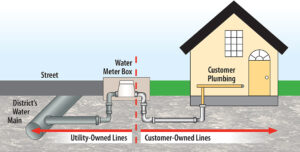
In an effort to significantly lower the risk of exposure to lead and copper in our nation’s drinking water, the Environmental Protection Agency (EPA) is requiring all Water Districts to perform a Lead Service Line Inventory, and provide the results to the EPA.
As per the above diagram, two parts of the Service Line need to be assessed:
- Utility-Owned: the line that runs from our water main to your water meter
- Customer-Owned: the line that runs from the water meter to your home
 North City Water District has never used lead in our service lines from the main to the meter, and King County banned the use of lead service lines in the late 1960s. However, if your home was built before 1970, it could have lead pipe in the customer-owned section of line between the water meter (which is typically located at the property boundary) and your home.
North City Water District has never used lead in our service lines from the main to the meter, and King County banned the use of lead service lines in the late 1960s. However, if your home was built before 1970, it could have lead pipe in the customer-owned section of line between the water meter (which is typically located at the property boundary) and your home.
North City Water District staff have been building a database of every property in our service area (roughly 8,300 accounts) that identifies the date when water lines were installed, both on our side of the meter, as well as yours. To do this, we’ve been combing through historical contracts, design standards, and the King County Plumbing code back to when our first water mains were installed in 1936—to identify if lead was ever allowed in our system.
Step 1: Online survey
We would like to ask your assistance in helping us gather critical information via a simple survey… which you can complete in one of three ways:
Option 1: take our online survey >
Option 2: download the Interactive Survey and fill it out electronically. The fields in this PDF version are interactive — you can type directly into each field, save the document, then attach it to an email (along with any photo attachments you might have) to leadservicelines@northcitywater.org
Option 3: download the Printable Survey, print it out, fill it out by hand, then drop it off at our office, or send it to us by postal mail to North City Water District – 1519 NE 177th Street, Shoreline, WA 98155.
Step 2: Physical water line inspection
For all properties that can not be identified via historical contract documents or survey results, we will need to conduct a physical inspection. Using the Washington state Department of Health’s recommended statistical approach, this will amount to roughly 370 residences.
If you are one of the ~370 homes identified for inspection, here’s what to expect:
Our crews will open up your meter box to inspect your water service line materials. You do not need to be home, and no service outage will occur.
If we’re unable to confirm the water line materials from the meter box, we’ll reach out to you by delivering this flyer containing a proposed schedule for a second visit, along with instructions for how you can contact us.
During the second visit, we’ll need access to your crawlspace or garage—wherever the water line enters your home—to inspect it there. Someone will need to be home to give us access, but no service outage will occur.
If we’re still unable to confirm water line materials from your crawlspace or garage, we’ll need to hydro-excavate a small pit on one or both sides of your water meter. You will be notified well in advance, and will only be out of service for a short time. We’ll backfill the pit to its prior surface elevation, and either seed grass, or finish with landscape bark or crushed rock to match the surroundings.
